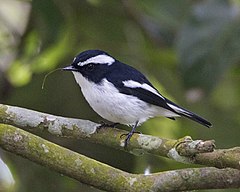Ficedula
| Ficedula | |||
| Brisson, 1760[1] | |||
 Muchołówka srokata (F. westermanni) | |||
| Systematyka | |||
| Domena | |||
|---|---|---|---|
| Królestwo | |||
| Typ | |||
| Podtyp | |||
| Gromada | |||
| Podgromada | |||
| Infragromada | |||
| Rząd | |||
| Podrząd | |||
| Rodzina | |||
| Podrodzina | |||
| Rodzaj |
Ficedula | ||
| Typ nomenklatoryczny | |||
|
Motacilla hypoleuca Pallas, 1764 | |||
| Synonimy | |||
|
| |||
| Gatunki | |||
| |||
Ficedula – rodzaj ptaków z podrodziny kląskawek (Saxicolinae) w obrębie rodziny muchołówkowatych (Muscicapidae).
Rozmieszczenie geograficzne
Rodzaj obejmuje gatunki występujące w Eurazji i Afryce[5][6].
Morfologia
Długość ciała 9–14,5 cm; masa ciała 6–22,2 g[6].
Systematyka
Rodzaj zdefiniował w 1760 roku francuski zoolog Mathurin Jacques Brisson w publikacji własnego autorstwa poświęconej ornitologii[1]. Gatunkiem typowym jest (Linneuszowska tautonimia) muchołówka żałobna (F. hypoleuca).
Etymologia
- Ficedula: łac. ficedula ‘mały, jedzący figi ptak, który przemieniał się zimą w kapturkę (Sylvia atricapilla)’[7].
- Muscicapula: zrodzaj Muscicapa Brisson 1760 (muchołówka); łac. przyrostek zdrabniający -ula[8]. Gatunek typowy (późniejsze oznaczenie)[9]: Muscicapa sapphira Blyth, 1843.
- Nitidula: łac. nitidulus ‘nieco elegancki’, od nitidus ‘błyszczeć’, od nitere ‘lśnić’[10]. Gatunek typowy (oznaczenie monotypowe): Nitidula campbelli Blyth, 1861 (= Nemura hodgsoni F. Moore, 1854).
- Muscicapella: nowołac. muscicapella ‘muchołóweczka’, od rodzaju Muscicapa Brisson 1760 (muchołówka); łac. przyrostek zdrabniający -ella[11].
Podział systematyczny
Do rodzaju należą następujące gatunki[12]:
- Ficedula zanthopygia (A. Hay, 1845) – muchołówka żółtorzytna
- Ficedula narcissina (Temminck, 1836) – muchołówka złotobrewa
- Ficedula owstoni (Bangs, 1901) – muchołówka żółtawa
- Ficedula elisae (Weigold, 1922) – muchołówka zielonawa
- Ficedula hodgsoni (F. Moore, 1854) – muchołówka aksamitna
- Ficedula erithacus (Jerdon & Blyth, 1861) – muchołówka rdzawobrzucha
- Ficedula mugimaki (Temminck, 1836) – muchołówka syberyjska
- Ficedula strophiata (Hodgson, 1837) – muchołówka tarczowa
- Ficedula sapphira (Blyth, 1843) – muchołówka szafirowa
- Ficedula superciliaris (Jerdon, 1840) – muchołówka granatowa
- Ficedula westermanni (Sharpe, 1888) – muchołówka srokata
- Ficedula tricolor (Hodgson, 1845) – muchołówka trójbarwna
- Ficedula hyperythra (Blyth, 1843) – muchołówka białobrewa
- Ficedula ruficauda (Swainson, 1838) – muchołówka rudosterna
- Ficedula albicilla (Pallas, 1811) – muchołówka rdzawogardła
- Ficedula parva (Bechstein, 1792) – muchołówka mała
- Ficedula subrubra (E. Hartert & F. Steinbacher, 1934) – muchołówka kaszmirska
- Ficedula semitorquata (von Homeyer, 1885) – muchołówka półobrożna
- Ficedula hypoleuca (Pallas, 1764) – muchołówka żałobna
- Ficedula albicollis (Temminck, 1815) – muchołówka białoszyja
- Ficedula speculigera (Bonaparte, 1850) – muchołówka atlasowa
- Ficedula rufigula (Wallace, 1865) – muchołówka białobrzucha
- Ficedula buruensis (E. Hartert, 1899) – muchołówka ciemnogłowa
- Ficedula harterti (Siebers, 1928) – muchołówka brązowa
- Ficedula timorensis (Hellmayr, 1919) – muchołówka obrożna
- Ficedula basilanica (Sharpe, 1877) – muchołówka białopióra
- Ficedula crypta (Vaurie, 1951) – muchołówka płowa
- Ficedula luzoniensis (Ogilvie-Grant, 1894) – muchołówka filipińska
- Ficedula bonthaina (E. Hartert, 1896) – muchołówka rdzawobrewa
- Ficedula nigrorufa (Jerdon, 1839) – muchołówka czarnogłowa
- Ficedula riedeli (Büttikofer, 1886) – muchołówka tanimbarska
- Ficedula dumetoria (Wallace, 1864) – muchołówka białoskrzydła
- Ficedula disposita (Ripley & J.T. Marshall, Jr., 1967) – muchołówka luzońska
- Ficedula platenae (W. Blasius, 1888) – muchołówka palawańska
- Ficedula henrici (E. Hartert, 1899) – muchołówka diademowa
Uwagi
- ↑ Młodszy homonim Nitidula Fabricius, 1775 (Coleoptera).
- ↑ Nowa nazwa dla Nitidula Blyth, 1861.
Przypisy
- ↑ a b M.J. Brisoon: Ornithologie, ou, Méthode contenant la division des oiseaux en ordres, sections, genres, especes & leurs variétés: a laquelle on a joint une description exacte de chaque espece, avec les citations des auteurs qui en ont traité, les noms quils leur ont donnés, ceux que leur ont donnés les différentes nations, & les noms vulgaires. T. 3. Parisiis: Ad Ripam Augustinorum, apud Cl. Joannem-Baptistam Bauche, bibliopolam, ad Insigne S. Genovesae, & S. Joannis in Deserto, 1760, s. 369. (łac. • fr.).
- ↑ E. Blyth. Mr. Blyth's monthly Report for December Meeting, 1842, with Addenda subsequently appended. „The Journal of the Asiatic Society of Bengal”. 12 (2), s. 939, 1843. (ang.).
- ↑ E. Blyth. Notes on some Birds collected by Dr. Jerdon in Sikkim. „Proceedings of the Zoological Society of London”. 29, s. 201, 1861. (ang.).
- ↑ V.L. Bianchi. Коллекція рыбъ, собранныхъ Н. А. Байковымъ въ Маньчжуріи, въ бассейне р. Мудань-цзяна. „Ежегодникъ Зооюгическаго Музея Імператоркоҋ Академіи Наукъ”. 12, s. 70, 1907. (ros.).
- ↑ F. Gill, D. Donsker & P. Rasmussen (red.): Chats, Old World flycatchers. IOC World Bird List (v14.2). [dostęp 2024-12-01]. (ang.).
- ↑ a b D.W. Winkler, S.M. Billerman & I.J. Lovette, Old World Flycatchers (Muscicapidae), version 1.0, [w:] S.M. Billerman, B.K. Keeney, P.G. Rodewald & T.S. Schulenberg (redaktorzy), Birds of the World, Cornell Lab of Ornithology, Ithaca, NY 2020, Ficedula, DOI: 10.2173/bow.muscic3.01 [dostęp 2024-12-01] (ang.).

- ↑ The Key to Scientific Names ↓, Ficedula [dostęp 2017-04-27].
- ↑ The Key to Scientific Names ↓, Muscicapula [dostęp 2017-04-27].
- ↑ G.R. Gray: Catalogue of the genera and subgenera of birds contained in the British Museum. London: The Trustees, 1855, s. 52. (ang.).
- ↑ The Key to Scientific Names ↓, Nitidula [dostęp 2017-04-27].
- ↑ The Key to Scientific Names ↓, Muscicapella [dostęp 2017-04-27].
- ↑ Systematyka i nazwy polskie za: P. Mielczarek & M. Kuziemko: Podrodzina: Saxicolinae Vigors, 1825 - kląskawki (wersja: 2024-10-19). [w:] Kompletna lista ptaków świata [on-line]. Instytut Nauk o Środowisku Uniwersytetu Jagiellońskiego. [dostęp 2024-12-01].
Bibliografia
- The Key to Scientific Names, J.A. Jobling (red.), [w:] Birds of the World, S.M. Billerman et al. (red.), Cornell Lab of Ornithology, Ithaca (ang.).
